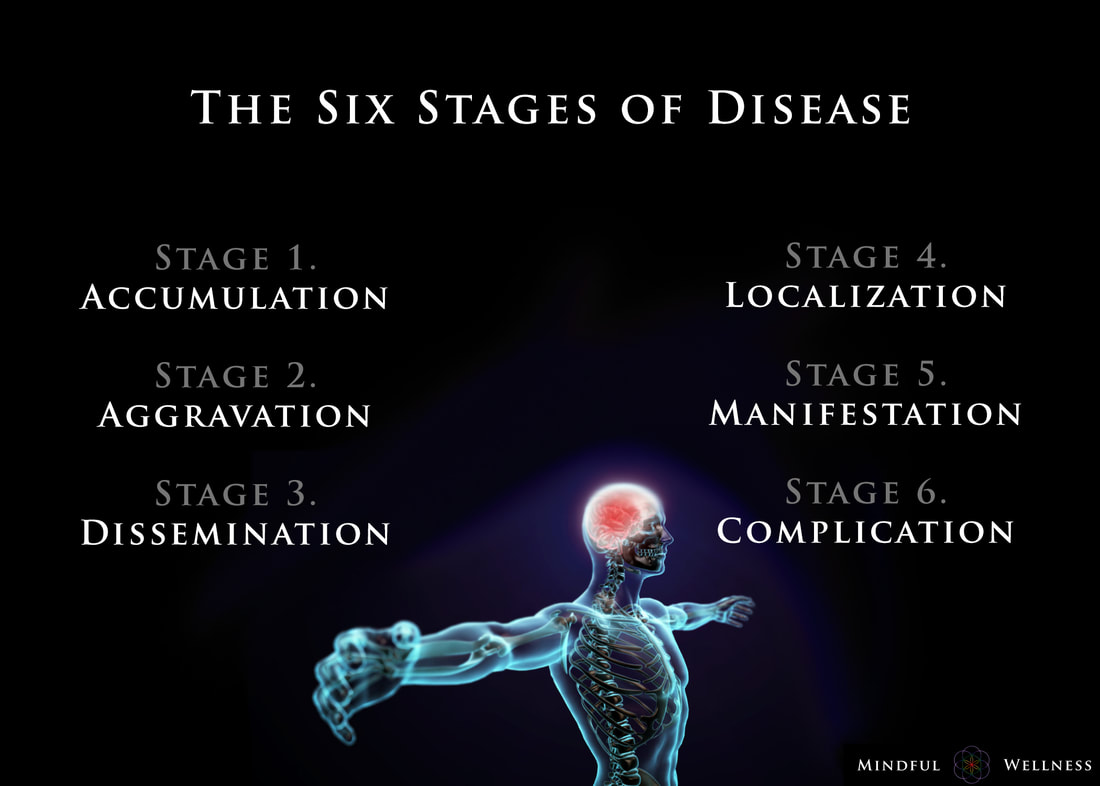Ayurveda offers insight into the earlier stages and enables those monitoring their health to take care of any small imbalances well before developing any serious illness. The length of the each stage may vary from weeks, to months, even years, depending on the person and the degree of aggravation. The six stages of disease development are:
1. Accumulation The first stage, accumulation, represents imbalance, a build up or collection of something in the body. Being exposed to and acquiring a pathogen via the external environment is an example of accumulation. This stage can also be caused by the internal environment, such as from eating an imbalanced diet leading to excess inflammation or mucous. Accumulation in the body leads to the the next stage, aggravation. 2. Aggravation As the imbalanced elements continue to increase, the symptoms become more aggravated and will begin to be noticed throughout the body. This stage is a sign of continued accumulation. This stage can manifest, as seen in the Kapha state, as loss of appetite, indigestion, nausea, excess saliva, oversleeping, sluggishness; or as seen in the Pitta state, as increased acidity, burning sensations in the abdomen, lowered vitality, or insomnia; or as seen in the Vata state, as pain in the lower abdomen, excess flatulence, and light-headedness. 3. dissemination Once the site of origin is full with excess accumulation and is aggravated, it will begin to overflow into or disseminate throughout the rest of the body using different channels of transportation. Overflow typically begins in the GI tract, then spilling into the circulating plasma and blood, allowing the accumulation to spread systemically, and eventually seeping into the organs and tissues (dhātus). Simultaneously, the symptoms at the site of origin will grow worse. 4. Localization The excess accumulation will then move to wherever a weak site exists in the body. This is where and when diseases begin to develop. This stage is also where genetics matter; the weak spots are determined by genetics - as the saying goes, genetics loads the gun, environment pulls the trigger. This stage can manifest, as seen in the Vata state, as arthritis. In a Pitta state, this can be seen as an ulcer, and in the Kapha state, manifestation may begin in the lungs. At this stage, healing is still regarded as simple. 5. Manifestation This is the first state of the development of illness for which modern Western medicine can detect signs of disease. It is at this stage where diseases progress and become fully developed, showing signs of clinical features. Manifested imbalances are given names at this stage, such as arthrosclerosis, cancer, colitis, etc. It is at this stage where conventional medicine attempts to mask the symptoms by offering pharmaceutical drugs. 6. Complication Complications of the dis-ease begin at this final stage. Often times, conventional medicine attempts to solve the problem by simply removing the affected tissue (e.g., small intenstine, colon, thyroid, etc.) from the body. The symptoms become clear enough so that the elemental cause (i.e., dosha constitution such as Vata, Kapha, Pitta) may be determined. Some medical professionals describe this stage as the chronic phase of development. For example, if one develops inflammation in the manifestation stage, in this stage, complications set in, and the inflammation may grow worse into a chronic problem. Being aware of the stages of the dis-ease process is helpful because one can gain a better understanding in how prevent, and perhaps even reverse, it. To be clear, the information provided here is not claiming to treat, cure or diagnose disease. ReferencesCabral, S. (2018). The 6 Stages of the Disease Process (Ayurvedic Principle). [podcast] The Cabral Concept. Available at: https://itunes.apple.com/us/podcast/cabral-concept-by-stephen/id1071469441?mt=2
Tirtha, S. (2007). The Āyuveda encyclopedia. Bayville, NY. Ayurveda Holistic Center Press.
0 Comments
The First World Medicine Ayurveda is considered a world medicine and the most comprehensive medical system available containing the ancient wisdom of healing, prevention, and longevity. Healers from all over the world gathered to impart their medical knowledge to India. The famous sage, Veda Vyasa, preserved the all of the knowledge of Ayurveda in texts. Some say Ayurveda was passed down from the Gods to humans. The knowledge of Ayurveda includes methods of herbs, foods, aromas, gems, colors, yoga, mantras, lifestyle, and surgery. Health was, and to this day is, seen as as an integral part of spiritual life. It has been said that Ayurvedic teachings can be directly obtained via meditation or divine revelation, as guessing or animal testing was unnecessary. These revelations were transcribed from oral teachings into written form. In the beginning, four main books, known as the Vedas: Rik, Sama, Yajur, and Atharva, spirituality existed and included holistic integrated topics such as health, ecology, astrology, spiritual business, government, military, poetry, and ethical living. Ayurveda was used side by side with Vedic astrology, also known as "one's inner light", and is said to have its main origins in the Atharva branch (upaveda) which covered the healing aspects of life and spirituality as a whole. In sum, this branch shows how to remain balanced with nature. The Rik Vedas included topics such as organ transplants, prosthetics, and the use of herbs to heal imbalances of the mind and body to promote longevity. In addition, within the Rik Vedas are dialogs of the three constitutions (doshas): air (Vāyu ["Vata"] ), fire (Pitta), and water (Kapha). Ayurveda became scientifically verifiable once two Ayurvedic schools, the school of physicians (Ātreya) and the school of surgeons (Dhanvantari), transformed the science through research and testing. This caused Auyrveda to grow and became a widely used system of healing in India. The Vedas are considered to contain eternal wholistic wisdom, adapting to the needs of time. Throughout the teachings, it is cleared stated that the first cause of illness is loss of faith in spirituality. In other words, when people do not recognize that all is one, including themselves, this separation of vision creates an opening, consequently creating a longing or suffering for oneness of vision. This suffering manifests as the beginning of physical, mental, or spiritual dis-ease. People from cultures throughout the world, such as the Chinese, Tibetians, Greeks, Romans, Egyptians, Afghanis, Persians, and others, traveled to India to absorb and disseminate the wisdom. Ayurveda was first discovered by travelers on India's Silk Road, an established trade route spanning between Asia, the Middle East, and Europe. The two schools of Ayurveda were created by two distinguished researchers: Charak and Sushruta. Charak represents the school of physicians which discusses physiology, anatomy, etiology, pathogenesis, symptoms and signs of dis-ease, methodology of diagnosis, treatment and prescription for patients, prevention, longevity, and internal/external causes of illness. As mentioned above, the internal cause of is the loss of faith, the loss of oneness. External influences on health includes the time of day, the seasons, diet, and lifestyle. Sushruta represents the school of surgeons which discusses sophisticated accounts of anatomy, surgical equipment, classification of abscesses, burns, fractures, wounds, amputation, plastic surgery, and anal/rectal surgery, all of which have been corroborated by modern scientific investigation. References Tirtha, S. (2007). The Āyuveda encyclopedia. Bayville, NY. Ayurveda Holistic Center Press.
|
The Awareness domain contains research, news, information, observations, and ideas at the level of self in an effort to intellectualize health concepts.
The Lifestyle domain builds off intellectual concepts and offers practical applications.
Taking care of yourself is at the core of the other domains because the others depend on your health and wellness.
Archives
May 2024
Categories
All
|



 RSS Feed
RSS Feed

